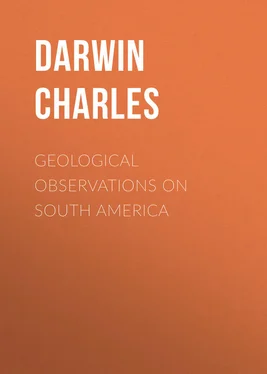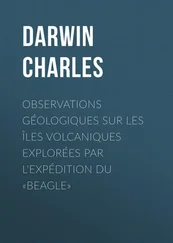Charles Darwin - Geological Observations on South America
Здесь есть возможность читать онлайн «Charles Darwin - Geological Observations on South America» — ознакомительный отрывок электронной книги совершенно бесплатно, а после прочтения отрывка купить полную версию. В некоторых случаях можно слушать аудио, скачать через торрент в формате fb2 и присутствует краткое содержание. Жанр: foreign_antique, foreign_prose, на английском языке. Описание произведения, (предисловие) а так же отзывы посетителей доступны на портале библиотеки ЛибКат.
- Название:Geological Observations on South America
- Автор:
- Жанр:
- Год:неизвестен
- ISBN:нет данных
- Рейтинг книги:3 / 5. Голосов: 1
-
Избранное:Добавить в избранное
- Отзывы:
-
Ваша оценка:
- 60
- 1
- 2
- 3
- 4
- 5
Geological Observations on South America: краткое содержание, описание и аннотация
Предлагаем к чтению аннотацию, описание, краткое содержание или предисловие (зависит от того, что написал сам автор книги «Geological Observations on South America»). Если вы не нашли необходимую информацию о книге — напишите в комментариях, мы постараемся отыскать её.
Geological Observations on South America — читать онлайн ознакомительный отрывок
Ниже представлен текст книги, разбитый по страницам. Система сохранения места последней прочитанной страницы, позволяет с удобством читать онлайн бесплатно книгу «Geological Observations on South America», без необходимости каждый раз заново искать на чём Вы остановились. Поставьте закладку, и сможете в любой момент перейти на страницу, на которой закончили чтение.
Интервал:
Закладка:
Ten miles southward, but 120 miles to the west, at Port S. Antonio, the Officers employed on the Survey assured me that they saw many old sea- shells strewed on the surface of the ground, similar to those found on other parts of the coast of Patagonia. At San Josef, ninety miles south in nearly the same longitude, I found, above the gravel, which caps an old tertiary formation, an irregular bed and hillock of sand, several feet in thickness, abounding with shells of Patella deaurita, Mytilus Magellanicus, the latter retaining much of its colour; Fusus Magellanicus (and a variety of the same), and a large Balanus (probably B. Tulipa), all now found on this coast: I estimated this bed at from eighty to one hundred feet above the level of the sea. To the westward of this bay, there is a plain estimated at between two hundred and three hundred feet in height: this plain seems, from many measurements, to be a continuation of the sandstone platform of the river Negro. The next place southward, where I landed, was at Port Desire, 340 miles distant; but from the intermediate districts I received, through the kindness of the Officers of the Survey, especially from Lieutenant Stokes and Mr. King, many specimens and sketches, quite sufficient to show the general uniformity of the whole line of coast. I may here state, that the whole of Patagonia consists of a tertiary formation, resting on and sometimes surrounding hills of porphyry and quartz: the surface is worn into many wide valleys and into level step-formed plains, rising one above another, all capped by irregular beds of gravel, chiefly composed of porphyritic rocks. This gravel formation will be separately described at the end of the chapter.
My object in giving the following measurements of the plains, as taken by the Officers of the Survey, is, as will hereafter be seen, to show the remarkable equability of the recent elevatory movements. Round the southern parts of Nuevo Gulf, as far as the River Chupat (seventy miles southward of San Josef), there appear to be several plains, of which the best defined are here represented.
(In the following Diagrams: 1. Baseline is Level of sea. 2. Scale is 1/20 of inch to 100 feet vertical. 3. Height is shown in feet thus: An. M. always stands for angular or trigonometrical measurement. Ba. M. always stands for barometrical measurement. Est. always stands for estimation by the Officers of the Survey.
DIAGRAM 1. SECTION OF STEP-FORMED PLAINS SOUTH OF NUEVO GULF.
From East (sea level) to West (high):
Terrace 1. 80 Est.
Terrace 2. 200-220 An. M.
Terrace 3. 350 An. M.)
The upper plain is here well defined (called Table Hills); its edge forms a cliff or line of escarpment many miles in length, projecting over a lower plain. The lowest plain corresponds with that at San Josef with the recent shells on its surface. Between this lowest and the uppermost plain, there is probably more than one step-formed terrace: several measurements show the existence of the intermediate one of the height given in Diagram 1.
(DIAGRAM 2. SECTION OF PLAINS IN THE BAY OF ST. GEORGE.
From East (sea level) to West (high):
Terrace 1. 250 An. M.
Terrace 2. 330 An. M.
Terrace 3. 580 An. M.
Terraces 4, 5 and 6 not measured.
Terrace 7. 1,200 Est.)
Near the north headland of the great Bay of St. George (100 miles south of the Chupat), two well-marked plains of 250 and 330 feet were measured: these are said to sweep round a great part of the Bay. At its south headland, 120 miles distant from the north headland, the 250 feet plain was again measured. In the middle of the bay, a higher plain was found at two neighbouring places (Tilli Roads and C. Marques) to be 580 feet in height. Above this plain, towards the interior, Mr. Stokes informs me that there were several other step-formed plains, the highest of which was estimated at 1,200 feet, and was seen ranging at apparently the same height for 150 miles northward. All these plains have been worn into great valleys and much denuded. The section in Diagram 3 is illustrative of the general structure of the great Bay of St. George. At the south headland of the Bay of St. George (near C. Three Points) the 250 plain is very extensive.
(DIAGRAM 3. SECTION OF PLAINS AT PORT DESIRE.
From East (sea level) to West (high):
Terrace 1. 100 Est.
Terrace 2. 245-255 Ba. M. Shells on surface.
Terrace 3. 330 Ba. M. Shells on surface.
Terrace 4. Not measured.)
At Port Desire (forty miles southward) I made several measurements with the barometer of a plain, which extends along the north side of the port and along the open coast, and which varies from 245 to 255 feet in height: this plain abuts against the foot of a higher plain of 330 feet, which extends also far northward along the coast, and likewise into the interior. In the distance a higher inland platform was seen, of which I do not know the height. In three separate places, I observed the cliff of the 245-255 feet plain, fringed by a terrace or narrow plain estimated at about one hundred feet in height. These plains are represented in the section Diagram 3.
In many places, even at the distance of three and four miles from the coast, I found on the gravel-capped surface of the 245-255 feet, and of the 330 feet plain, shells of Mytilus Magellanicus, M. edulis, Patella deaurita, and another Patella, too much worn to be identified, but apparently similar to one found abundantly adhering to the leaves of the kelp. These species are the commonest now living on this coast. The shells all appeared very old; the blue of the mussels was much faded; and only traces of colour could be perceived in the Patellas, of which the outer surfaces were scaling off. They lay scattered on the smooth surface of the gravel, but abounded most in certain patches, especially at the heads of the smaller valleys: they generally contained sand in their insides; and I presume that they have been washed by alluvial action out of thin sandy layers, traces of which may sometimes be seen covering the gravel. The several plains have very level surfaces; but all are scooped out by numerous broad, winding, flat-bottomed valleys, in which, judging from the bushes, streams never flow. These remarks on the state of the shells, and on the nature of the plains, apply to the following cases, so need not be repeated.
(DIAGRAM 4. SECTION OF PLAINS AT PORT S. JULIAN.
From East (sea level) to West (high):
Terrace 1. Shells on surface. 90 Est.
Terrace 2. 430 An. M.
Terrace 3. 560 An. M.
Terrace 4. 950 An. M.)
Southward of Port Desire, the plains have been greatly denuded, with only small pieces of tableland marking their former extension. But opposite Bird Island, two considerable step-formed plains were measured, and found respectively to be 350 and 590 feet in height. This latter plain extends along the coast close to Port St. Julian (110 miles south of Port Desire); see Diagram 4.
The lowest plain was estimated at ninety feet: it is remarkable from the usual gravel-bed being deeply worn into hollows, which are filled up with, as well as the general surface covered by, sandy and reddish earthy matter: in one of the hollows thus filled up, the skeleton of the Macrauchenia Patachonica, as will hereafter be described, was embedded. On the surface and in the upper parts of this earthy mass, there were numerous shells of Mytilus Magellanicus and M. edulis, Patella deaurita, and fragments of other species. This plain is tolerably level, but not extensive; it forms a promontory seven or eight miles long, and three or four wide. The upper plains in Diagram 4 were measured by the Officers of the Survey; they were all capped by thick beds of gravel, and were all more or less denuded; the 950 plain consists merely of separate, truncated, gravel-capped hills, two of which, by measurement, were found to differ only three feet. The 430 feet plain extends, apparently with hardly a break, to near the northern entrance of the Rio Santa Cruz (fifty miles to the south); but it was there found to be only 330 feet in height.
Читать дальшеИнтервал:
Закладка:
Похожие книги на «Geological Observations on South America»
Представляем Вашему вниманию похожие книги на «Geological Observations on South America» списком для выбора. Мы отобрали схожую по названию и смыслу литературу в надежде предоставить читателям больше вариантов отыскать новые, интересные, ещё непрочитанные произведения.
Обсуждение, отзывы о книге «Geological Observations on South America» и просто собственные мнения читателей. Оставьте ваши комментарии, напишите, что Вы думаете о произведении, его смысле или главных героях. Укажите что конкретно понравилось, а что нет, и почему Вы так считаете.












